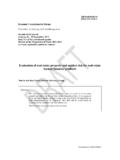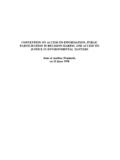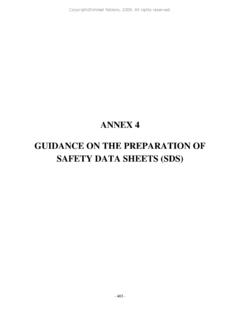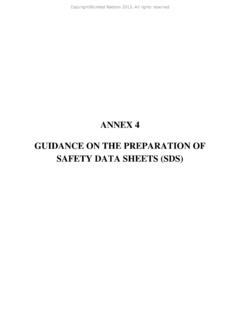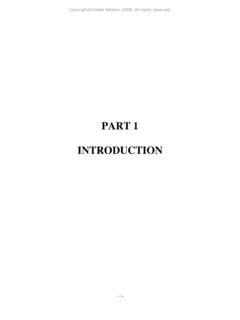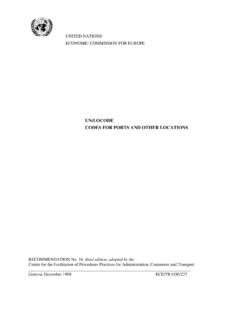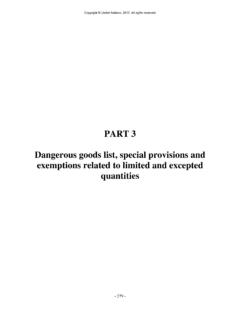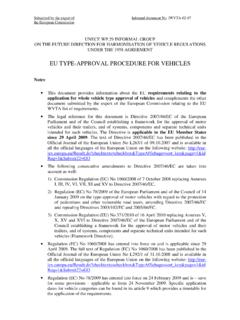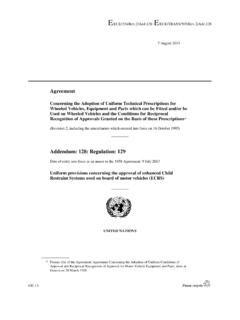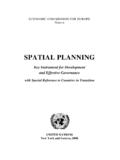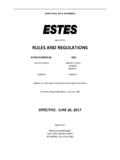Transcription of Road Traffic Convention 1968 e - UNECE Homepage
1 - 3 - Convention ON ROAD Traffic The Contracting Parties, Desiring to facilitate international road Traffic and to increase road safety through the adoption of uniform Traffic rules , Have agreed upon the following provisions: Chapter I GENERAL PROVISIONS ARTICLE 1 Definitions For the purpose of this Convention the following expressions shall have the meanings hereby assigned to them: (a) The "domestic legislation" of a Contracting Party means the entire body of national or local laws and regulations in force in the territory of that Contracting Party; (b) A vehicle is said to be "in international Traffic " in the territory of a State if: (i) It is owned by a natural or legal person normally resident outside that State; (ii) It is not registered in that State; and (iii) It is temporarily imported into that State; provided, however, that a Contracting Party may refuse to regard as being "in international Traffic " a vehicle which has remained in its territory for more than one year without a substantial interruption, the duration of which may be fixed by that Contracting Party.
2 A combination of vehicles is said to be "in international Traffic " if at least one of the vehicles in the combination conforms to the above definition; (c) "Built-up area" means an area with entries and exits specially signposted as such, or otherwise defined in domestic legislation; - 4 - (d) "Road" means the entire surface of any way or street open to public Traffic ; (e) "Carriageway" means the part of a road normally used by vehicular Traffic ; a road may comprise several carriageways clearly separated from one another by, for example, a dividing strip or a difference of level; (f) On carriageways where one or more side lanes or tracks are reserved for use by certain vehicles, "edge of the carriageway" means, for other road-users, the edge of the remainder of the carriageway; (g) "Lane" means any one of the longitudinal strips into which the carriageway is divisible, whether or not defined by longitudinal road markings, which is wide enough for one moving line of motor vehicles other than motor cycles; (h) "Intersection" means any level crossroad, junction or fork, including the open areas formed by such crossroads, junctions or forks; (i) "Level-crossing" means any level intersection between a road and a railway or tramway track with its own track formation.
3 (j) "Motorway" means a road specially designed and built for motor Traffic , which does not serve properties bordering on it, and which: (i) Is provided, except at special points or temporarily, with separate carriageways for the two directions of Traffic , separated from each other either by a dividing strip not intended for Traffic or, exceptionally, by other means; (ii) Does not cross at level with any road, railway or tramway track, or footpath; and (iii) Is specially signposted as a motorway; (k) A vehicle is said to be: (i) "Standing" if it is stationary for the time needed to pick up or set down persons or to load or unload goods; and (ii) "Parked" if it is stationary for any reason other than the need to avoid interference with another road-user or collision with an obstruction or to comply with Traffic regulations, and if the period during which the vehicle is stationary is not limited to the time needed to pick up or set down persons or goods; Nevertheless, it shall be open to Contracting Parties to regard as "standing" any vehicle which is stationary within the meaning of subparagraph (ii) above for a period not exceeding that fixed by domestic legislation, and to regard as "parked" any vehicle which is stationary within the meaning of subparagraph (i) above for a period exceeding that fixed by domestic legislation.
4 - 5 - (l) "Cycle" means any vehicle which has at least two wheels and is propelled solely by the muscular energy of the persons on that vehicle, in particular by means of pedals or hand-cranks; (m) "Moped" means any two-wheeled or three-wheeled vehicle which is fitted with an internal combustion engine having a cylinder capacity not exceeding 50 cc and a maximum design speed not exceeding 50 km (30 miles) per hour. Contracting Parties are free, however, not to regard as mopeds, under their domestic legislation, vehicles which do not have the characteristics of a cycle with respect to their use, in particular the characteristic that they can be propelled by pedals, or whose maximum design speed, whose mass, or certain of whose engine characteristics exceed certain limits. Nothing in this definition shall be construed as preventing Contracting Parties from treating mopeds exactly as cycles in applying the provisions of their domestic legislation regarding road Traffic ; (n) "Motor cycle" means any two-wheeled vehicle, with or without a side-car, which is equipped with a propelling engine.
5 Contracting Parties may also treat as motor cycles in their domestic legislation three-wheeled vehicles whose unladen mass does not exceed 400 kg. The term "motor cycle" does not include mopeds, although Contracting Parties may, provided they make a declaration to this effect in conformity with Article 54, paragraph 2, of this Convention , treat mopeds as motor cycles for the purposes of the Convention ; (o) "Power-driven vehicle" means any self-propelled road vehicle, other than a moped in the territories of Contracting Parties which do not treat mopeds as motor cycles, and other than a rail-borne vehicle; (p) "Motor vehicle" means any power-driven vehicle which is normally used for carrying persons or goods by road or for drawing, on the road, vehicles used for the carriage of persons or goods. This term embraces trolley-buses, that is to say, vehicles connected to an electric conductor and not rail-borne.
6 It does not cover vehicles, such as agricultural tractors, which are only incidentally used for carrying persons or goods by road or for drawing, on the road, vehicles used for the carriage of persons or goods; (q) "Trailer" means any vehicle designed to be drawn by a power-driven vehicle and includes semi-trailers; (r) "Semi-trailer" means any trailer designed to be coupled to a motor vehicle in such a way that part of it rests on the motor vehicle and that a substantial part of its mass and of the mass of its load is borne by the motor vehicle; (s) "Light trailer" means any trailer of a permissible maximum mass not exceeding 750 kg; (t) "Combination of vehicles" means coupled vehicles which travel on the road as a unit; (u) "Articulated vehicle" means a combination of vehicles comprising a motor vehicle and semi-trailer coupled to the motor vehicle; - 6 - (v) "Driver" means any person who drives a motor vehicle or other vehicle (including a cycle), or who guides cattle, singly or in herds, or flocks, or draught, pack or saddle animals on a road; (w) "Permissible maximum mass" means the maximum mass of the laden vehicle declared permissible by the competent authority of the State in which the vehicle is registered; (x) "Unladen mass" means the mass of the vehicle without crew, passengers or load, but with a full supply of fuel and with the tools which the vehicle normally carries; (y) "Laden mass" means the actual mass of the vehicle as loaded, with the crew and passengers on board; (z) "Direction of Traffic " and "appropriate to the direction of Traffic " mean the right-hand side if, under domestic legislation, the driver of a vehicle must allow an oncoming vehicle to pass on his left.
7 Otherwise these expressions mean the left-hand side; (aa) The requirement that a driver shall "give way" to other vehicles means that he must not continue or resume his advance or manoeuvre if by so doing he might compel the drivers of other vehicles to change the direction or speed of their vehicle abruptly. ARTICLE 2 Annexes to the Convention The Annexes to this Convention , namely, Annex 1: Exceptions to the obligation to admit motor vehicles and trailers in international Traffic ; Annex 2: Registration number of motor vehicles and trailers in international Traffic ; Annex 3: Distinguishing sign of motor vehicles and trailers in international Traffic ; Annex 4: Identification marks of motor vehicles and trailers in international Traffic ; Annex 5: Technical conditions concerning motor vehicles and trailers; Annex 6: Domestic driving permit; and Annex 7: International driving permit; are integral parts of this Convention .
8 - 7 - ARTICLE 3 Obligations of the Contracting Parties 1. (a) Contracting Parties shall take appropriate measures to ensure that the rules of the road in force in their territories conform in substance to the provisions of Chapter II of this Convention . Provided that the said rules are in no way incompatible with the said provisions: (i) The said rules need not reproduce any of the said provisions which are applicable to situations that do not arise in the territories of the Contracting Parties in question; (ii) The said rules may include provisions not contained in the said Chapter II. (b) The provisions of this paragraph do not require Contracting Parties to provide penalties for any violation of those provisions of Chapter II which are reproduced in their rules of the road. 2. (a) Contracting Parties shall also take appropriate measures to ensure that the rules in force in their territories concerning the technical requirements to be satisfied by motor vehicles and trailers conform to the provisions of Annex 5 to this Convention ; provided that they are in no way contrary to the safety principles governing the provisions of Annex 5, the said rules may contain provisions not contained in Annex 5.
9 Contracting Parties shall also take appropriate measures to ensure that motor vehicles and trailers registered in their territories conform to the provisions of Annex 5 to this Convention when entering international Traffic . (b) The provisions of this paragraph do not impose any obligations on the Contracting Parties with respect to the rules in force in their territories concerning the technical requirements to be satisfied by power-driven vehicles which are not motor vehicles within the meaning of this Convention . 3. Subject to the exceptions provided for in Annex 1 to this Convention , Contracting Parties shall be bound to admit to their territories in international Traffic motor vehicles and trailers which fulfil the conditions laid down in Chapter III of this Convention and whose drivers fulfil the conditions laid down in Chapter IV; they shall also be bound to recognize registration certificates issued in accordance with the provisions of Chapter III as prima facie evidence that the vehicles to which they refer fulfil the conditions laid down in the said Chapter III.
10 4. Measures which the Contracting Parties have taken or may take, either unilaterally or under bilateral or multilateral agreements, to admit to their territories in international Traffic motor vehicles and trailers that do not satisfy all the conditions stated in Chapter III of this Convention and to recognize, in cases other than those specified in Chapter IV, the validity in their territories of driving permits issued in the territory of another Contracting Party shall be deemed to be in conformity with the object of this Convention . - 8 - 5. Contracting Parties shall be bound to admit to their territories in international Traffic cycles and mopeds which fulfil the technical conditions laid down in Chapter V of this Convention and whose drivers have their normal residence in the territory of another Contracting Party. No Contracting Party shall require the drivers of cycles or mopeds in international Traffic to hold a driving permit; however, Contracting Parties which have declared in conformity with Article 54, paragraph 2, of this Convention that they treat mopeds as motor cycles may require the drivers of mopeds in international Traffic to hold a driving permit.
